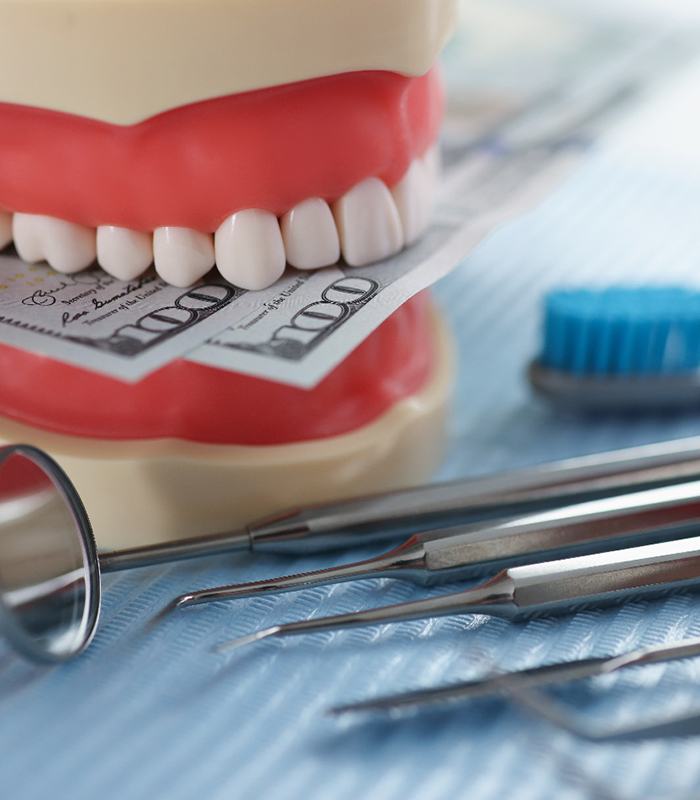
Root Canal Therapy – Jonesboro, AR
Put an End to Tooth Pain
Thanks to TV shows and films, root canal therapy doesn’t have the best reputation. However, despite what you may have seen on the big screen, root canal therapy is a virtually painless procedure that is used to repair damaged teeth and save them from being extracted. If you are eager to put an end to your tooth pain, Dr. Shane Smith has you covered! Give us a call to learn more about root canal therapy in Jonesboro and schedule an urgent visit to get some relief.
Do I Need Root Canal Therapy?
Having a toothache doesn’t always mean that you need root canal therapy, but it is a common sign. This service is reserved for teeth that have become damaged, decayed, or infected to the point where they can’t be treated with just a filling or dental crown. Here are some popular symptoms that may signify that you could benefit from root canal therapy:
- Severe toothache or dental pain that has lasted for more than 24 hours
- New or worsening tooth sensitivity to hot or cold temperatures
- Pain in one or more teeth when you bite down
- Swollen, red, or tender gums
- A bump on the gums near the painful tooth that resembles a pimple
If you have one or more of the symptoms listed above, contact our office to schedule a same-day appointment for emergencies.
The Root Canal Process
Root canal therapy is used to save teeth that are damaged and ultimately eliminate discomfort. First, you are administered a local anesthetic to ensure that you’re comfortable during your procedure. The area will be completely numb, so you won’t be able to feel a thing.
The Benefits of Getting a Root Canal
Root canal therapy is a safe way to prevent dental problems from occurring later on. Some of the benefits include:
- Preserves Damaged Teeth: When compared to extractions, saving a tooth with root canal therapy can save you a lot of time, money, and future complications.
- Stop Harmful Bacteria: Root canal therapy cleans away harmful particles that are causing you pain and discomfort.
- Painless Treatment: Root canal therapy is virtually painless! It’s about as comfortable as getting a standard filling and requires much less healing time than an extraction.
Understanding the Cost of Root Canals

Even if you believe you should get a root canal, you may want to know the prices involved first. Unfortunately, though, Dr. Smith can’t give you an exact estimate ahead of time. Various factors apply to the cost of a root canal in Jonesboro, so you’d need to book a consultation with our office to learn the details. Once we’ve examined you during this visit, we can give you an accurate price for treatment.
If you’d like to learn more about this process, keep reading or call our office today!
Factors That Can Affect Root Canal Cost

As mentioned above, a dentist can’t determine a root canal’s cost until they’ve assessed the tooth or teeth in question. In particular, they’ll consider the following when assessing the final price:
- Type & Location of the Tooth: For example, treating molars is more expensive since they have more roots. In contrast, front teeth only have one root each and thus cost less.
- The Difficulty of the Treatment: If the treated tooth is heavily damaged or decayed, you’ll pay more than you would for one with lighter injuries or decay.
- Whether You Need Additional Services: In some cases, a dentist may need to follow up on root canal therapy with a dental crown. Should that happen, your overall treatment expenses will increase.
Is it Cheaper to Pull My Tooth?

To cut costs, some patients consider pulling a tooth instead of getting a root canal. However, this isn’t a great choice to make.
True enough, tooth extraction may be the cheaper option in the short term. That said, losing a natural tooth has long-term consequences. Not only will it hurt your bite as the remaining teeth shift out of place, but it’ll also make eating difficult and cause discomfort. Adding insult to injury, solving these adverse effects requires a dental implant or bridge — services that cost money.
Ultimately, it’s more cost-effective to save a tooth than to pay for replacing it later. You should do so soon, too, as waiting around makes the need for an extraction more likely.
Does Dental Insurance Cover Root Canal Therapy?

Root canal therapy falls under urgent dental care, thus making it a major procedure. As such, dental insurance plans usually cover 50-80% of its cost once you pay the deductible.
Still, keep in mind that every plan is different. Before you commit to treatment, confirm your coverage with your insurance provider first. Our team will even help with this process!
Other Options for Making Root Canal Therapy Affordable

Even if you don’t have insurance, the cost of a root canal can be affordable. In particular, our practice offers flexible financing through third-party services like CareCredit. That way, patients can pay for services with monthly installments, all at little-to-no interest.
As headed by Dr. Shane Smith, DDS, our office’s team is always ready to assist patients with root canals. We’ll do everything possible to help you navigate the cost, so go ahead and call us for help!
Root Canal FAQs
What Should I Do Before a Root Canal?
One of the first things you should do prior to your appointment is to get well-deserved sleep the night before. This can help prepare your nerves and your immune system so that you can recover smoothly and as quickly as possible. Be sure to eat a healthy meal before arriving at our office, as this can be difficult to do a couple of hours after your procedure. You’ll also need to refrain from drinking alcohol and/or using tobacco before your root canal, as this can interfere with the local anesthetic. You might even consider taking over-the-counter pain medication, like ibuprofen, immediately ahead of your visit for the best comfort.
How Much Pain Is Normal After a Root Canal?
Since you’ll be provided with a local anesthetic, you should not experience any discomfort throughout your root canal therapy. However, it’s natural to expect mild soreness over the following several days. Once your mouth is no longer numb, you may experience slight sensitivity. Fortunately, this sensation is typically short-lived and can easily be managed with over-the-counter pain relievers, such as acetaminophen and ibuprofen. Try not to chew hard or crunchy foods while you recover. And if any discomfort hasn’t improved after three days, don’t hesitate to reach out to us for help.
Do I Need Antibiotics Before or After My Root Canal?
Not every patient will require antibiotics before or after undergoing a root canal. This is typically only necessary for those who have a health condition that makes them more vulnerable to getting an infection after receiving a major dental procedure. To avoid any surprises, we’ll walk you through your medical and dental history beforehand, that way we can determine if prescribing antibiotics is a viable step for your treatment.
Are Root Canals Covered by Dental Insurance?
One of the primary things dental insurance covers is routine care, such as checkups and cleanings, which could have prevented the need for root canal therapy in the first place. That said, most insurance plans will still cover a portion of the cost of treatment after you’ve met your deductible and before reaching your annual maximum. This is because a root canal is generally considered an essential restorative procedure. For this reason, dental insurance usually offers up to 50% coverage!
How Long Does it Take to Recover from a Root Canal?
Recovery from a root canal generally takes a few days to a week, though it can vary depending on the individual. After the procedure, some discomfort or mild pain is common, especially in the first 24-48 hours. Over-the-counter pain relievers are usually sufficient to manage this.
Most patients can return to normal activities the next day, but it’s advised to avoid chewing on the treated tooth until the final crown or restoration is placed. Swelling or tenderness may last for a few days, but these symptoms should gradually subside.
Full healing of the tissue around the tooth can take a few weeks, but you typically won’t experience pain during that time. Follow-up visits with us ensure the root canal was successful and the tooth is healing properly.
How Long Do Root Canals Last?
A root canal can last a lifetime with proper care. The procedure itself removes the infected or damaged pulp, but the tooth remains functional. After the root canal, the tooth is typically restored with a crown or filling, which helps protect and strengthen it.
Several factors influence the longevity of a root canal, including the quality of the restoration, the tooth’s location (back teeth endure more pressure), and your oral hygiene habits. Proper brushing, flossing, and regular dental visits are essential for maintaining the health of the treated tooth.
While root canals are generally successful long-term, there’s a small chance the tooth may need retreatment if the area becomes reinfected. However, with good care, a root canal-treated tooth can remain healthy and functional for many years, even decades.
What Happens if You Wait Too Long for a Root Canal?
Delaying a root canal can lead to serious complications. If the infection or decay inside the tooth is not treated promptly, the bacteria can spread to the surrounding tissues, causing an abscess. This can result in swelling, pain, and even bone loss around the tooth.
Additionally, the infection can spread to other areas of the body, potentially leading to systemic health issues. Prolonged infection may also damage the tooth to the point where it cannot be saved, resulting in the need for extraction.
Waiting too long for a root canal can increase the complexity and cost of treatment, so it's best to address the problem early to prevent more severe consequences.
Are Root Canals Painful?
Root canals have a reputation for being painful, but modern dental techniques and anesthesia make the procedure relatively comfortable. During the root canal, local anesthesia is used to numb the area, so most patients feel little to no pain during the procedure itself. In fact, a root canal is often performed to relieve the pain caused by an infected or damaged tooth.
After the procedure, it's normal to experience some mild discomfort or soreness for a few days, which can be managed with over-the-counter pain relievers. The discomfort is usually far less intense than the pain caused by the infection before the root canal.
With proper care, most patients find the process manageable and experience significant relief once the infection is treated.